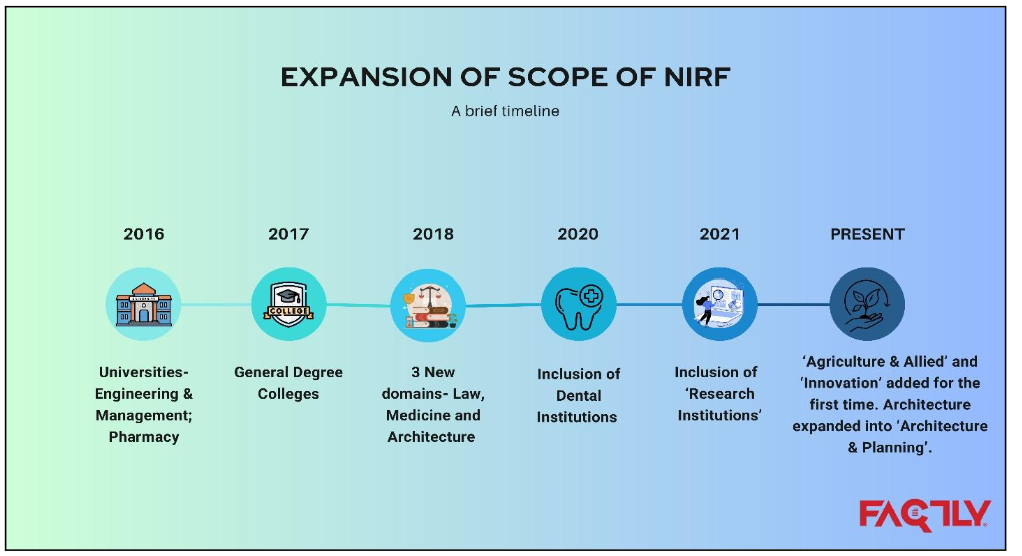The NIRF employs an evaluation system based on five broad and inclusive parameters: Teaching, Learning, and Resources (TLR), Research and Professional Practice (RP), Graduation Outcome (GO), Outreach and Inclusivity (OI), and Perception (PR). Data from the past eight editions indicates that the average scores increased across most disciplines.
Every individual, in their lifetime, finds themselves at a crossroads, faced with the daunting task of making choices among a myriad of options. In a quest to unravel the complexity of decision-making, a common strategy emerged — the creation of objective criteria to guide choices. The educational landscape is no exception, presenting a multifaceted decision-making scenario. Fortunately, the availability of institutional rankings simplifies this complexity.
The inception of the National Institutional Ranking Framework (NIRF) stands as a prudent initiative by the Ministry of Education (MoE) aimed at evaluating and ranking higher education institutions throughout India. This framework serves as a comprehensive guide for the assessment and ranking of institutions across the nation.
Each player in this vast ecosystem perceives these rankings in a unique light – aspiring students aim to enter top-ranked colleges, while recruiters often bank on educational rankings, or ‘brand name’ as often called, for their recruitments. Other stakeholders such as foreign institutions also accord significant weightage to these rankings.
In the series of articles on NIRF rankings, we explore the rankings and the nuances behind them in detail. This first story is primarily focused on a brief introduction, the methodology behind rankings, the evolution of the framework over the years, and broad overall trends.
How did NIRF come into existence?
The formulation process of NIRF commenced on 9 October 2014, marked by the establishment of a 16-member core committee chaired by the Secretary of Higher Education, Ministry of Human Resource Development. The committee’s mandate was to propose a National Framework that is dependable, transparent, and credible for assessing and ranking higher education institutions. Additionally, it was tasked with recommending institutional mechanisms, processes, and implementation timelines for the National Institutional Ranking Framework.
The 2023 edition is the Eighth consecutive edition of India Rankings of institutions of higher education.
How are these rankings calculated?
The ranking framework employs an evaluation system based on five broad and inclusive parameters: Teaching, Learning, and Resources (TLR), Research and Professional Practice (RP), Graduation Outcome (GO), Outreach and Inclusivity (OI), and Perception (PR). Institutions are ranked according to the cumulative marks they secure across these five overarching categories. A notable feature of this framework is its adaptability and flexibility.

The final ranking framework encompasses 16-18 parameters organized into five broad generic categories. While many parameters align with global standards, reflecting the environment for teaching, learning, and research, some are specific to India. These India-centric parameters mirror the aspirations of the increasing number of young people enrolled in higher education institutions and include considerations such as regional diversity, outreach, gender equity, and the inclusion of disadvantaged sections of society.

How has NIRF’s scope expanded since inception?
In 2016, the NIRF introduced rankings for universities and three subject domains: Engineering, Management, and Pharmacy. The following year, 2017, marked the expansion with the addition of Overall rankings and rankings for General Degree Colleges. Continuing this trend in 2018, the framework maintained six rankings and incorporated three domain-specific rankings for Law, Medicine, and Architecture.
The year 2019 saw the continuation of the six existing rankings, including Overall, Universities, and Colleges, and the addition of six domain-specific rankings introduced between 2017 and 2018. Subsequently, in 2020, the NIRF expanded further by introducing rankings for “Dental” institutions, and in 2021, it included rankings for “Research Institutions.”
In 2022, NIRF persisted with rankings in four categories: Overall, Universities, Colleges, and Research Institutions, and seven subject domains: Engineering, Management, Pharmacy, Medicine, Architecture, Law, and Dental. In 2023, two additional verticals, namely “Agriculture & Allied Sectors” and “Innovation,” are being introduced for the first time. Furthermore, the subject domain “Architecture” is being broadened and renamed as “Architecture & Planning” to encompass institutions offering courses in urban and town planning. With the inclusion of Agriculture and allied Sectors, Innovation, and the expansion of the scope of Architecture, a total of 13 categories and subject domains were ranked in India Rankings 2023.

Performance of NIRF institutions over the years
Since this ranking is primarily curated using the data from the applicant institutions themselves, the acceptability of this framework among the institutions is, by itself a key success metric. The number of participating institutions in the rankings stood at 5543 unique institutions in 2023. This represents a growth of 97% from 2809 institutions in 2018, indicating the growing popularity and acceptability of the framework.
Further, the improvement in the average scores across each category of educational institutions Y-o-Y indicates the commitment of these institutions to improve their ranking. The average scores in the Engineering category grew from 47.1 to 54.1 between 2017 and 2023, whereas for universities it rose from 41.9 to 51.5 during the same period. For management and Pharmacy institutions, the average score rose from 51.2 to 54.3 and 45.6 to 51.4 respectively in the same period. Dental institutions showed a decline in their average scores since their inclusion, as is the case with Law.
Overall top colleges remain almost the same
The framework has undergone multiple revisions over the years. Modifications in metrics, parameters, and normalization algorithms have been incorporated over the years, yet the fundamental framework has been preserved. Consequently, the ranking of institutions has largely remained stable, especially among the top 25, although there may have been slight alterations in individual ranks for some institutions due to variations in performance across specific parameters. This underscores the compact, coherent, and interdependent nature of the parameters utilized for ranking.
Among the overall toppers, IIT Madras, IISc Bangalore, IIT Delhi, IIT Bombay, IIT Kharagpur and IIT Kanpur have always been in the top 10.
Featured Image: NIRF Evaluation System


